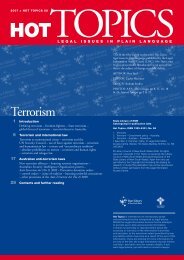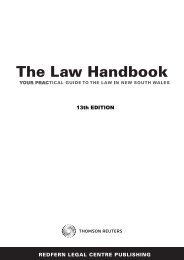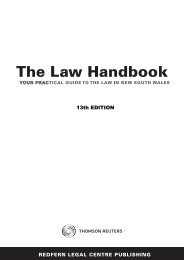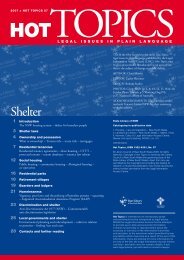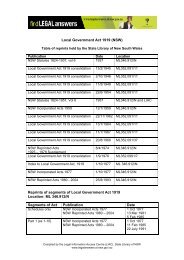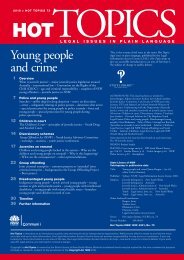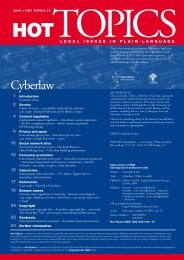Guide to termination and unfair dismissal rights of - Legal ...
Guide to termination and unfair dismissal rights of - Legal ...
Guide to termination and unfair dismissal rights of - Legal ...
- No tags were found...
Create successful ePaper yourself
Turn your PDF publications into a flip-book with our unique Google optimized e-Paper software.
• An employer is not legally required <strong>to</strong> give notice under the FWAct where an employee’s actionsamount <strong>to</strong> serious misconduct. 15 In other words, the notice entitlements under the FWAct do notapply <strong>to</strong> serious misconduct situations. However, it will still be necessary for the employer <strong>to</strong> inform theemployee <strong>of</strong> the <strong>termination</strong> <strong>of</strong> the employee’s employment <strong>and</strong> the reason for the <strong>termination</strong>. Theremay be a dispute between the employer <strong>and</strong> employee about whether or not the conduct occurred orwhether or not it was serious misconduct. The dispute may lead <strong>to</strong> an <strong>unfair</strong> <strong>dismissal</strong> claim or someother legal claim.16• Where the employee is a casual employee. True casual employment consists <strong>of</strong> a series <strong>of</strong>employment periods without an expectation <strong>of</strong> ongoing work. This is a difficult area <strong>of</strong> employment lawbecause there is a fine line between permanent work <strong>and</strong> casual work.For example, a shift worker who is contacted by the employer ahead <strong>of</strong> each roster period <strong>and</strong> is given avariety <strong>of</strong> shifts each time, or sometimes no shifts, will likely be a casual. It is not necessary <strong>to</strong> terminatethe employment <strong>of</strong> this type <strong>of</strong> worker. The employer may simply choose not <strong>to</strong> <strong>of</strong>fer any more shifts. Acontrasting situation would be where a shift worker works the same shifts over a long period <strong>of</strong> time,where the work situation gives the employee a real expectation <strong>of</strong> regular shifts in the future <strong>and</strong> theperiod <strong>of</strong> this arrangement is open ended. It is unlikely that a worker in this situation is truly a casualemployee.• Where an employee works under a training arrangement for a specified period <strong>and</strong> where it isagreed that employment will last for the length <strong>of</strong> the training period. 17 This will <strong>of</strong>ten apply <strong>to</strong>employees described as trainees. However it is important <strong>to</strong> note that this category <strong>of</strong> exclusion doesnot apply <strong>to</strong> apprentices because <strong>of</strong> the specific wording <strong>of</strong> the relevant provision <strong>of</strong> the FWAct.Accordingly, it is necessary <strong>to</strong> give notice <strong>to</strong> an employee who is an apprentice, despite the fact that theapprenticeship may be coming <strong>to</strong> an end.The FWAct contains an anti-avoidance provision <strong>to</strong> protect employees. The provision prevents employers frommisusing the above categories <strong>to</strong> avoid notice obligations. The provision applies where the substantial reasonfor employment under the category was <strong>to</strong> avoid notice obligations. 18 A good example <strong>of</strong> this may be “casual”employment. If an employer hires an employee <strong>to</strong> work regular part time hours but calls the employee a casual <strong>to</strong>avoid notice requirements, the anti-avoidance provision will operate. This will mean that the employer must stillgive <strong>termination</strong> notice under the FWAct.Finally, there are a number <strong>of</strong> other categories <strong>of</strong> employment where the giving <strong>of</strong> notice is not required. Insummary these include: daily hire employees in the building <strong>and</strong> construction industry; some daily hire <strong>and</strong>weekly hire employees in the meat industry. 19Notice entitlement amountsNotice entitlements are calculated in accordance with Table 1 below, which is found in the FWAct. 20 The period <strong>of</strong>employment coincides with the entitlement <strong>and</strong> the stated entitlements are not cumulative.Table 2PeriodEmployee’s period <strong>of</strong> continuous service with the employer atthe end <strong>of</strong> the day the notice is givenPeriod*1 Not more than 1 year 1 week2 More than 1 year but not more than 3 years 2 weeks3 More than 3 years but not more than 5 years 3 weeks4 More than 5 years 4 weeks*IMPORTANT – Where an employee is over 45 years <strong>of</strong> age <strong>and</strong> has completed at least 2 years <strong>of</strong> continuousservice, then the employee is <strong>to</strong> be given or paid 1 extra week <strong>of</strong> notice.6



